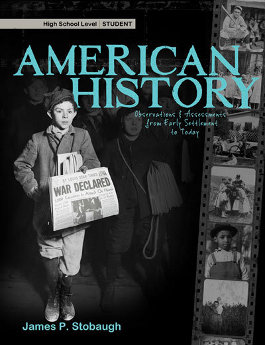Dr. James Stobaugh has written an unusual high school history series that should be especially appealing to those who want their teens to study history thoughtfully with an eye on the role of philosophies and world views.
The series consists of three, year-long courses: American History, British History, and World History. While the publisher recommends the courses be used in this order for grades 10 through 12, some ninth graders should be able to tackle the American History course, and you can change the order in which you use them.
Each course has a student book and a teacher manual. Courses all share the same layout with 34 chapters, each of which has four lessons and an exam. This works out to the completion of one lesson per week. Each day’s lesson concludes with from one to three questions, all of which will be answered with a full sentence or a paragraph or more. Some questions require students to respond using information drawn from the reading while others require them to think beyond the lesson material, frequently applying critical thinking to support their own opinion.
Instead of a recitation of political history focused heavily upon wars and conquests, Dr. Stobaugh’s approach emphasizes people, ideas, beliefs, and cultural forces. For example, learning objectives for the chapter on the American Civil War are:
- Compare the Northern and Southern views of the Union.
- Evaluate whether the South really had a chance to win the war.
- Predict what would have happened if the South had won the war.
- Discuss the impact of unforgiveness on a person and on a nation.
- Assess the impact of Abraham Lincoln on history.
Questions at the end of each lesson reflect these objectives, often phrasing questions similarly to the objectives themselves.
Chapter exams are found at the back of the teacher manual for each course. But even the exams are unusual. Sometimes they include matching exercises, true/false questions, and ordering of timeline events. More often they consist of essay or discussion questions. The entire exam might sometimes consist of only one or two discussion or essay questions! Exam questions can be dictated to students, written on a whiteboard, photocopied from the teacher manual, downloaded from a website (for free), or retyped by the teacher—whatever works best for you. Exams are intended for use without students referring to their text.
Teacher manuals include the first page of each chapter from the student book. This page has “First Thoughts…”—brief context or background information for the chapter content—and the learning objectives. The teacher manuals add notes showing which assignments address each of the learning objectives. This page is followed by two or three pages of suggested or specific answers to lesson and exam questions. There are no midterm or final exams.
Courses are designed for independent study. They are laid out very clearly in the student books where students read each day’s assignment and complete the questions. The amount of lesson material to cover each day is very manageable, typically one or two pages per day. American History, the lengthiest course, sometimes has up to four pages for one day’s lesson. While the amount of material is not overwhelming, the vocabulary and the ideas presented will challenge some students. This paragraph on King Henry VIII is typical: “His son, Henry VIII, was stronger and even more colorful, showing such promise at first. Later, he was a notorious womanizer, pragmatic egotist, and overbearing tyrant. He was, as it were, the perfect gentleman and vagabond Renaissance man rolled into one” (British History, p. 41).
Parents or teachers need to supply the exam questions as described above. While they should be able to assess student responses from the suggested answers in the teacher manual, I expect they will occasionally have to refer to the lesson material in the student book for further clarification.
All books are printed in black and white, but they are heavily illustrated with excellent graphics.
The courses reflect a Christian worldview that, while occasionally Protestant, is much more balanced and respectful of other Christians than most history resources used by homeschoolers.
Students who have not yet learned how to think will either find these courses refreshingly stimulating or frustratingly overwhelming. Students who are properly prepared should appreciate this approach to history that respects the intellect of the student and teaches them how to examine events as historiographers.















